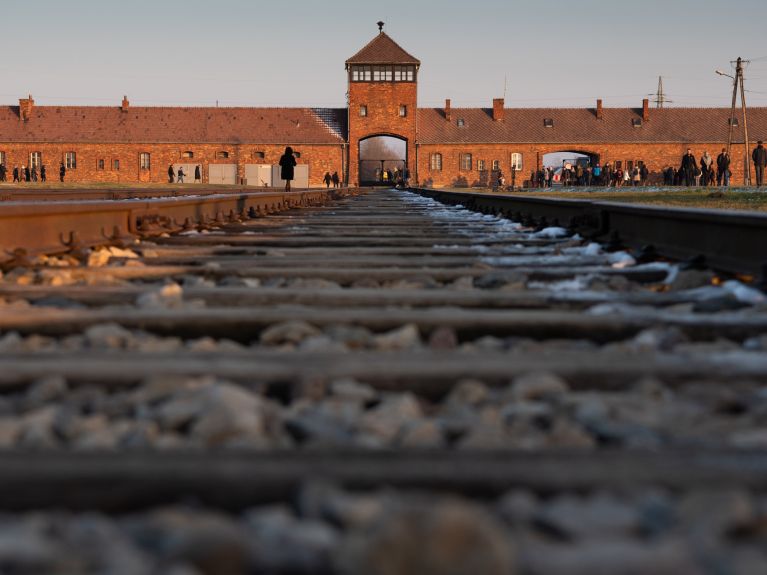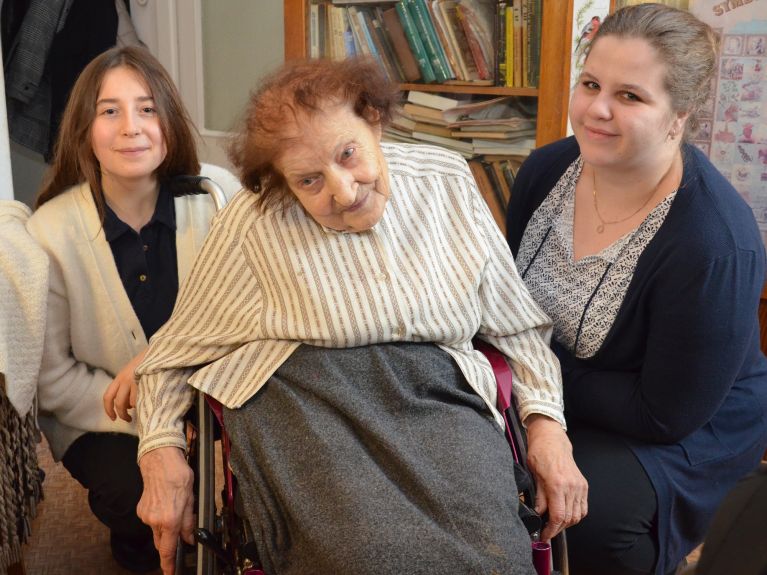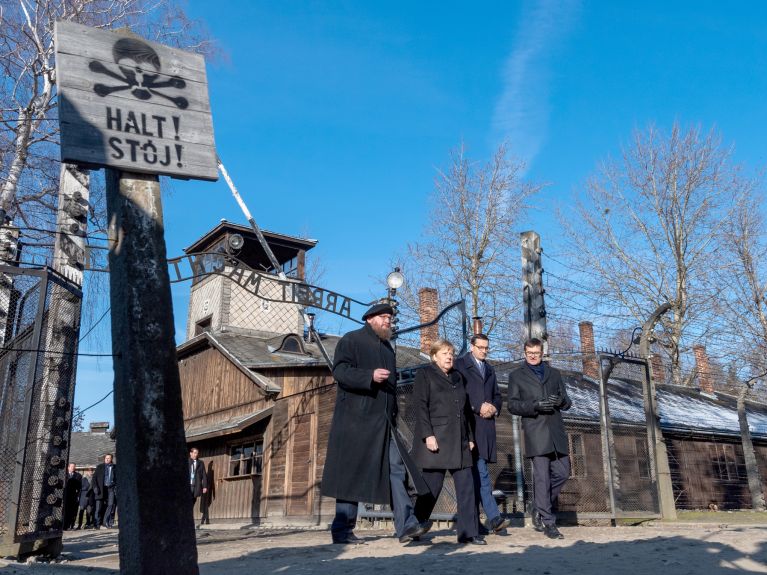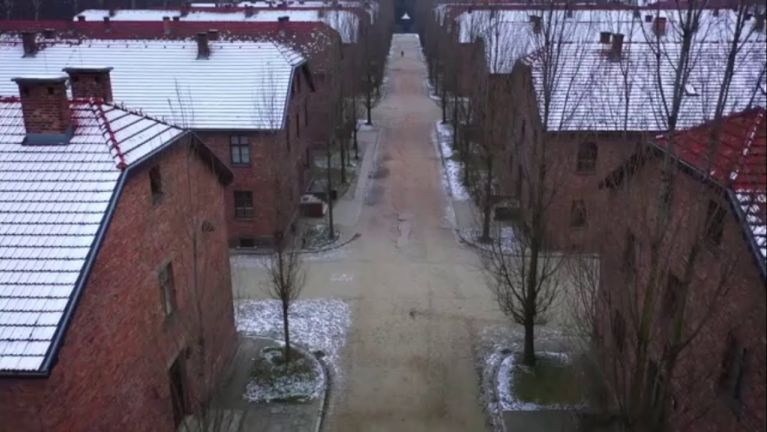Remembrance as a perpetual admonition
On 27 January the world commemorates the liberation of the Nazi extermination camp at Auschwitz 75 years ago. Some eyewitnesses are still alive and can tell their story.

It is next to impossible to condense the life of a 93-year-old person into a short narrative, all the more so in the case of Auschwitz survivor Anna. So make sure you devote enough time if you want to listen to her story. Anna Szałaśna sits in a wheelchair in her small apartment on the outskirts of Warsaw's old town, where she still manages her day-to-day life alone. First she tells how she lost a leg at the age of 13 in the war turmoil of September 1939, when she was hit by a bullet from her own Polish soldiers. This is a story in itself.
At that time her father takes the decision to amputate and is thus the first person to save the life of little Anna, who loves to play the piano so much. The family manages to make its way to southern Poland. But her beloved brother is arrested and deported to a concentration camp near Magdeburg. Anna writes to him again and again until, on one occasion, she ends with the sentence: "The important thing is that the moment of liberation is near." This letter is intercepted by the Gestapo. It's May 1943. Anna is 16, in the spring of her life. She wears a prosthesis instead of her left leg, but in normal times she would be able to play the piano, fall in love. But the times are not normal.
The memory is as vivid as if it happened only yesterday
Anna is transported to Auschwitz in a goods wagon. At the age of 93, she still remembers the first hours in the concentration camp as if it all happened yesterday. "Take your clothes off, everything!" She imitates the screaming voices of the guards. "They shaved off all our hair – from our heads, under our armpits, our pubic hair. Total nudity changes a person." Anna witnesses how in 1944 hundreds of thousands of Hungarian Jews are transported off in cattle trucks, gassed and cremated. "The crematoria were too small to cope with the numbers. So the bodies were dumped into huge pits. I will always remember the stench of burning human bones."

Anna Szałaśna survives Auschwitz thanks to fortunate coincidences and other people's help. In August 1944 she is transferred to the Ravensbrück concentration camp, where she experiences that 'moment of liberation' she had longed for in the letter to her brother in 1943. Further east, it is the Soviet Army that liberates Auschwitz on 27 January 1945. That's 75 years ago. Ever since 2005, the world has commemorated Holocaust Memorial Day on this date following a resolution at the United Nations. This will certainly still be the case in 25 years, on the 100th anniversary. And yet the forms of remembrance will be different then, because contemporary witnesses like Anna Szałaśna will not be there.
Remembering also means: "Never again"
What can be done to permanently secure a dignified commemoration of the victims of the Nazi terror and to combine it with the "never again" warning? "That is a difficult question to which there is no clear answer," says Piotr Cywiński, director of the Auschwitz-Birkenau State Museum, the official name of the concentration camp memorial, which has been on the UNESCO World Heritage List since 1979. Cywiński is also president of the Fundacja Auschwitz-Birkenau, which has its headquarters in Warsaw. The foundation, which was established in 2009 by the Auschwitz survivor and great German-Polish conciliator Władysław Bartoszewski, has set itself the goal of preserving the concentration camp memorial site and all its admonitory reminders of the past: the shoes and prisoners' clothing, the wooden spoons and soup bowls, but also the walls and barbed wire, the gas chambers and the crematoria.

It's not an easy task. On the contrary. The region around Auschwitz, today called Oświęcim not far from Krakow, is a watery, in some parts swampy landscape. For the SS this was one reason to build a concentration camp there in 1940: nature made any escape difficult. Today, the humidity makes the preservation of many exhibits, particularly the barracks, difficult, as Cywiński explains in an interview. And maintaining them costs money: "That is why we owe a great debt of gratitude to all our donors," emphasizes the museum director. The Federal Republic of Germany has always taken responsibility for financially supporting the foundation's work. In early December 2019, the federal and state governments decided to further increase their contributions to the capital stock by 30 million euros each.
Before Chancellor Angela Merkel's visit to the concentration camp memorial site at the beginning of December 2019, Cywiński explicitly acknowledged Germany's contribution but urged further efforts, not only financial, because "our memory already lets us down too often today". Taking on responsibility for the present based on remembering the past is something we do far too seldom, he continued. The 'Remembrance, Responsibility and Future Foundation' ('Stiftung Erinnerung, Verantwortung und Zukunft' – EVZ) is trying to counteract this; it was established in 2000 and is supported by the Federal Republic of Germany. In addition to compensating former Nazi forced labourers, a process that has been concluded in the meantime, the EVZ permanently finances projects that keep the memory of the victims alive and promote reconciliation.
Commitment of 'Aktion Sühnezeichen' (Action Reconciliation Service for Peace)
The Warsaw-based Polish-German Reconciliation Foundation takes a similar approach. Among other things, it supports social work by volunteers who take care of Nazi victims. Victims like Anna Szałaśna. Ruth Dahlhoff and Juliane Smykalla visit the 93-year-old once a week. The two young women from Germany, who have been living in Warsaw since October volunteering with the Action Reconciliation Service for Peace, "love talking to Pani Anna". To be more precise, they mainly listen – and in this way make their contribution to preserving the memory of the unspeakable horror that was Auschwitz.
Dieses YouTube-Video kann in einem neuen Tab abgespielt werden
YouTube öffnenThird party content
We use YouTube to embed content that may collect data about your activity. Please review the details and accept the service to see this content.
Open consent form

